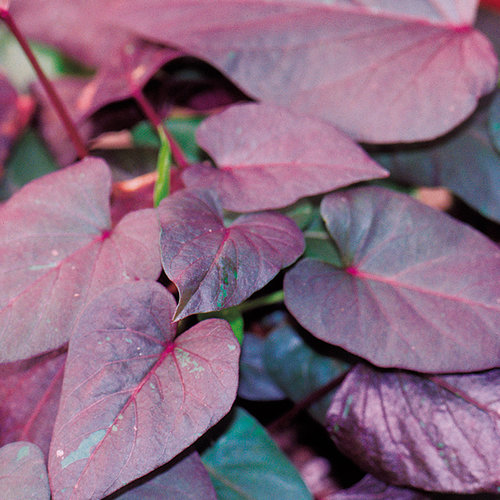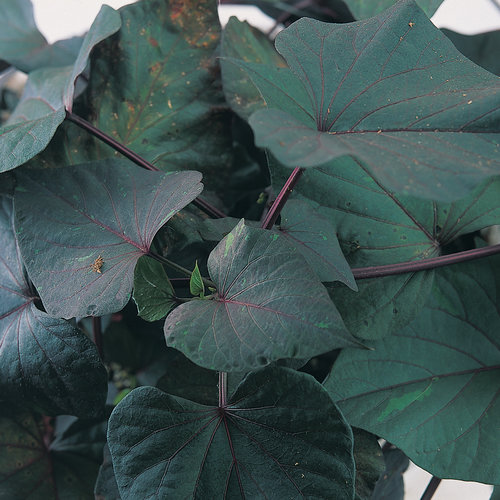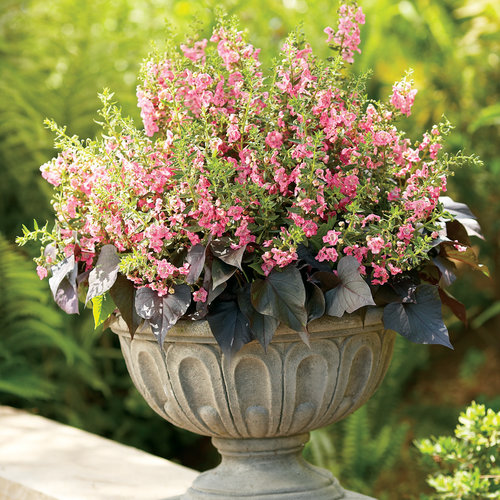Black Heart Sweet Potato Vine Ipomoea batatas
- Part Sun to Sun
- Spring
- Summer
-
Details
6 - 12 Inches18 - 24 Inches48 - 60 Inches15cm - 30cm46cm - 61cm1.2m - 1.5mFeatures
Garnet-purple, heart-shaped foliage
Award WinnerFoliage InterestHeat TolerantDeadheading Not NecessaryCharacteristics
Plant Type:AnnualHeight Category:ShortGarden Height:6 - 12 Inches 15cm - 30cmTrails Up To:72 Inches 1.8mSpacing:18 - 24 Inches 46cm - 61cmSpread:48 - 60 Inches 1.2m - 1.5mFlower Shade:NoneFoliage Colors:PurpleFoliage Shade:Black/PurpleHabit:TrailingContainer Role:SpillerPlant Needs
Light Requirement:Part Sun to SunThe optimum amount of sun or shade each plant needs to thrive: Full Sun (6+ hours), Part Sun (4-6 hours), Full Shade (up to 4 hours).
Maintenance Category:EasyBloom Time:Grown for FoliageHardiness Zones:11a, 11bWater Category:AverageUses:ContainerUses:LandscapeUses Notes:Use in hanging baskets, beds, borders and window boxes
Maintenance Notes:Ipomoeas are great additions to combination planters, but they can sometimes overwhelm less vigorous plants. If you are like me you can let your combination plants duke it out Darwinian style, however, if you prefer to keep a more balanced look to your combination planters, you can cut back or remove stems at any time.
Ipomoeas also make great annual groundcovers in the landscape. They love the heat and humidity (growing up to 36" a week in the Deep South), cooler temperatures and low humidity cause them to stay more compact.
While Sweet Potatoes all come from the same parent material out of Southeast Asia, there is a big difference between the Sweet Potato you buy in the store and the tubers produced by the Sweet Caroline and the Illusion plants. Commercial sweet potatoes have been bred for over 100 years selecting for those with the best sugar to starch content (hence the name SWEET Potato), the ornamental have been bred to produce good leaves and no tubers, though they do form, they are composed of almost pure starch and no sugar; making them a poor choice for eating. So yes you can eat the tubers, but don't expect anyone to come back for seconds! Also always be careful when eating any ornamental plant unless you know how it was grown, and if pesticides or fungicides were used on it before you got it; a tuber is a storage root, and yes they store chemical as well as starch.
An application of fertilizer or compost on garden beds and regular fertilization of plants in pots will help ensure the best possible performance.
"A Real Simple magazine Top 10 goofproof Plant"
"A Real Simple magazine - Top 10 goofproof Plant"
-
9 Reviews
554232111Browse reviews from people who have grown this plant.-
Russell Studebaker, Delaware, United States, 13 years ago
-
dirty fingers, Kansas, United States, 13 years ago
-
I use this plant to surround my in ground pool. I usually plant around 48 to fifty plants every year. They cascade over the stone wall and look wonderful.
Iris Michel, Kentucky, United States, 13 years ago -
Great plant and has the deepest of deep purple foliage. Loves the rain and sun. Huge growing spurt after I planted them.
Wes, Alberta, Canada, 13 years ago -
This was absolutely astonishing last year. I used it as a trailing ground cover. Unfortunately I have not been able to locate it this year. The greenhouse I purchased it from is not carring it this year. So sad
Rena Mowry, Wisconsin, United States, 13 years ago -
This was the most beautiful plant in front of my house running up a trellis and in my shrubs.
Brenda Burnham, Tennessee, United States, 13 years ago
4 Awards
Award Year Award Plant Trial 2004 Top Picks Cincinnati Zoo and Botanical Garden 2004 Top Picks Cincinnati Zoo and Botanical Garden 2004 Top Picks Cincinnati Zoo and Botanical Garden 2004 Top Picks Cincinnati Zoo and Botanical Garden -










